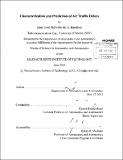| dc.contributor.advisor | Hamsa Balakrishnan. | en_US |
| dc.contributor.author | Rebollo de la Bandera, Juan José | en_US |
| dc.contributor.other | Massachusetts Institute of Technology. Dept. of Aeronautics and Astronautics. | en_US |
| dc.date.accessioned | 2013-01-07T21:21:21Z | |
| dc.date.available | 2013-01-07T21:21:21Z | |
| dc.date.copyright | 2012 | en_US |
| dc.date.issued | 2012 | en_US |
| dc.identifier.uri | http://hdl.handle.net/1721.1/76107 | |
| dc.description | Thesis (S.M.)--Massachusetts Institute of Technology, Dept. of Aeronautics and Astronautics, 2012. | en_US |
| dc.description | Cataloged from PDF version of thesis. | en_US |
| dc.description | Includes bibliographical references (p. 117-118). | en_US |
| dc.description.abstract | This thesis presents a new model for predicting delays in the National Airspace System (NAS). The proposed model uses Random Forest (RF) algorithms, considering both temporal and network delay states as explanatory variables. In addition to local delay variables that describe the arrival or departure delay states of the most influential airports and origin-destination (OD) pairs in the network, we propose new network delay variables that depict the global delay state of the entire NAS at the time of prediction. The local delay variables are identified by using a new methodology based on RF algorithms, and the importance levels of explanatory variables are used to select the most relevant variables. The high-level network delay variables are determined by using the k-means algorithm to cluster the delay state of different elements of the NAS. The thesis analyzes both the classification and regression performance of the proposed prediction models, which are trained and validated on 2007 and 2008 ASPM data. The predictive capabilities of the models are evaluated on the 100 most delayed OD pairs in the NAS. The results show that given a 2-hour prediction horizon, the average test error across these 100 OD pairs is 19% when classifying delays as above or below 60 min. The study of the 100 most delayed OD pairs allows us to evaluate and compare prediction models for different OD pairs, and to identify models with similar characteristics. The effect of changes in the classification threshold and prediction horizon on model performance are also studied. | en_US |
| dc.description.statementofresponsibility | by Juan José Rebollo de la Bandera. | en_US |
| dc.format.extent | 118 p. | en_US |
| dc.language.iso | eng | en_US |
| dc.publisher | Massachusetts Institute of Technology | en_US |
| dc.rights | M.I.T. theses are protected by
copyright. They may be viewed from this source for any purpose, but
reproduction or distribution in any format is prohibited without written
permission. See provided URL for inquiries about permission. | en_US |
| dc.rights.uri | http://dspace.mit.edu/handle/1721.1/7582 | en_US |
| dc.subject | Aeronautics and Astronautics. | en_US |
| dc.title | Characterization and prediction of air traffic delays | en_US |
| dc.type | Thesis | en_US |
| dc.description.degree | S.M. | en_US |
| dc.contributor.department | Massachusetts Institute of Technology. Department of Aeronautics and Astronautics | |
| dc.identifier.oclc | 820469676 | en_US |
